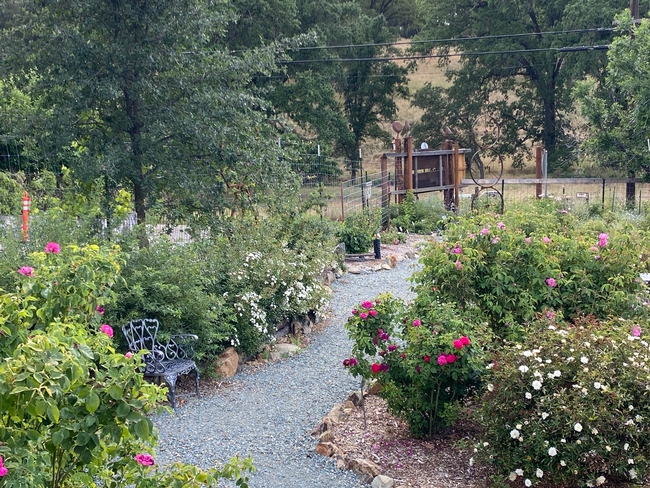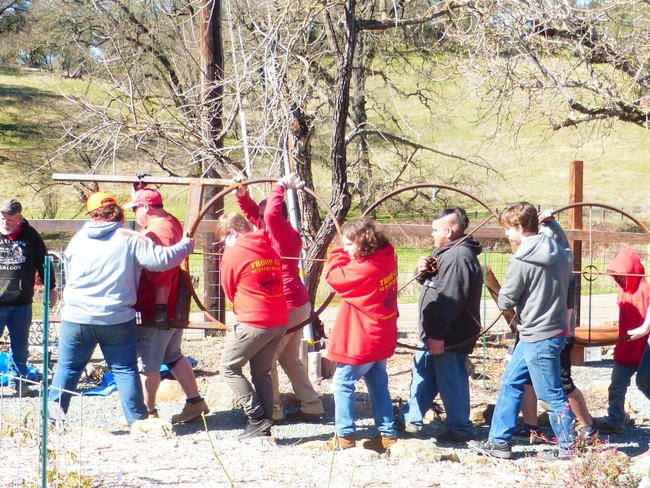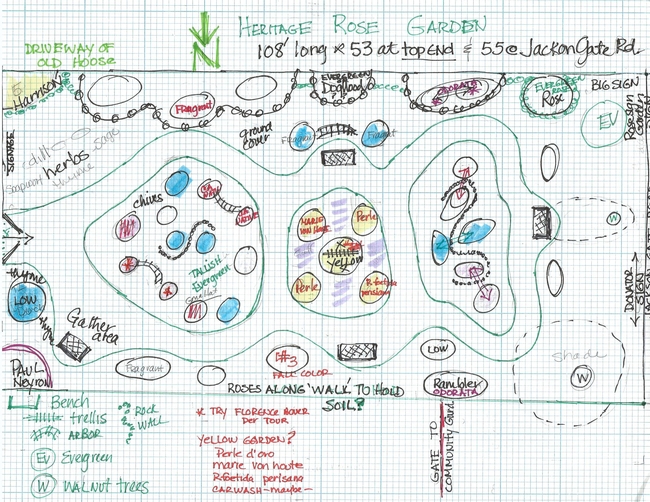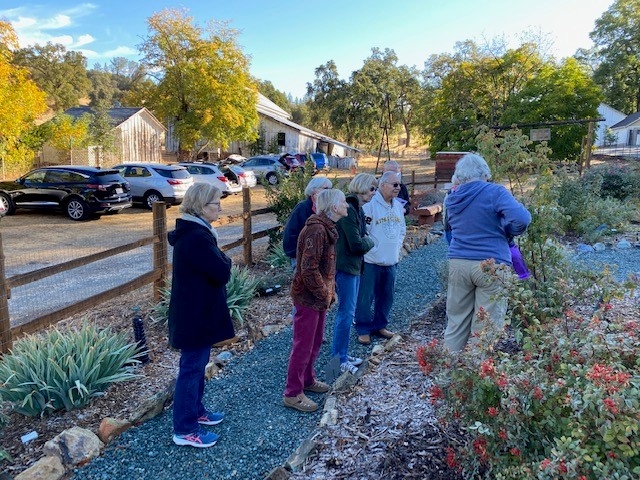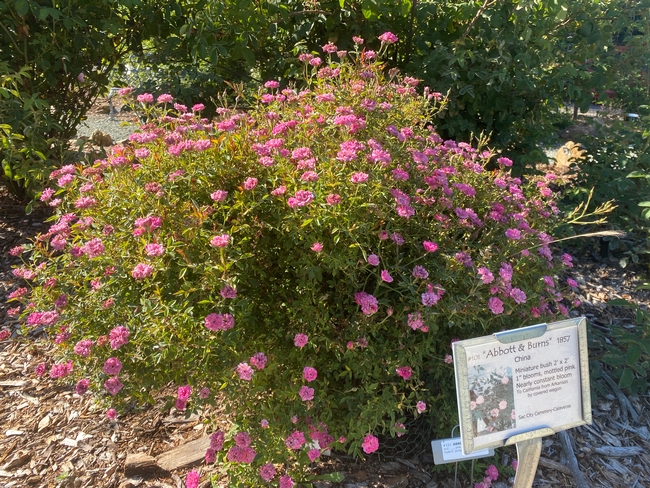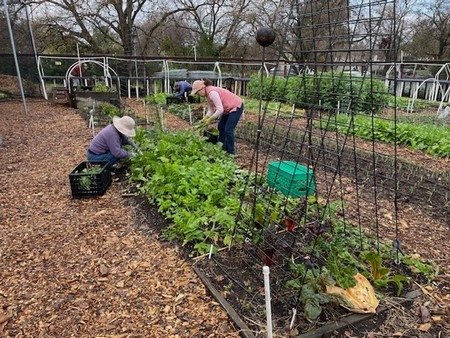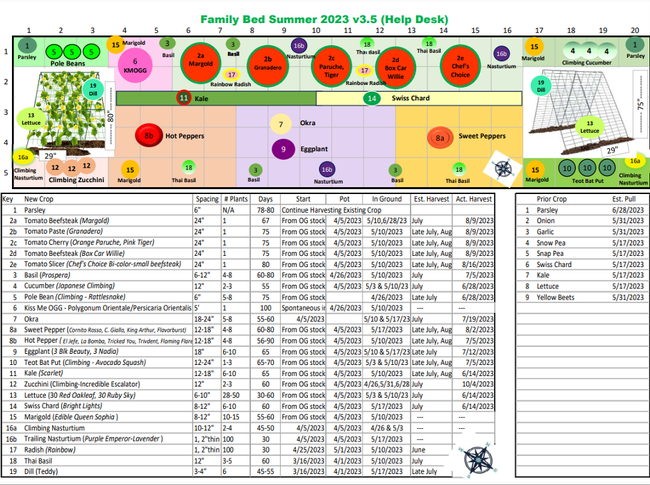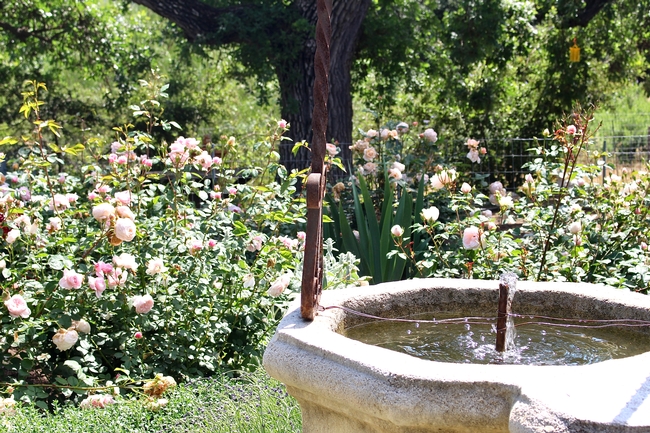From the UC Blogosphere...
Cultivating History and Community with The Heritage Rose Garden of Jackson, California
Cultivating History and Community with the Heritage Rose Garden of Jackson, California
Nestled in the heart of Amador County lies the Heritage Rose Garden, where the beauty of old roses meets the spirit of community. Here, UC Master Gardener volunteers have been hard at work, not only preserving the past but also teaching sustainable gardening practices to visitors from all walks of life.
The Heritage Rose Garden's story began with a mission to save a precious collection of heritage roses. Judy and Bob Dean, with their extensive collection of rare roses, narrowly escaped destruction during the Butte fire of 2015. Recognizing the need to protect these treasures, Bob Dean proposed the idea of creating a "backup" garden accessible to the public. This vision sparked a partnership between the UC Master Gardener Program and Mother Lode Land Trust (MLLT), aligning with their mission to preserve wildlife habitat and agriculture. Together, they laid the groundwork for a collaborative effort that blossomed into the Heritage Rose Garden located in Jackson, Calif. By 2023, the Heritage Rose Garden inspired continued partnership on the property with the completion of a propagation house, vegetable garden beds, fruit trees and compost education station. All of these new developments serve as a teaching space for the community. The Master Gardeners partnered in 2023 with Amador County Library to teach monthly hands-on, all-age workshops in this newly created space which is adjacent to the Heritage Rose Garden.
Guided by UC Cooperative Extension (UCCE) environmental horticulture advisors, UC Master Gardeners meticulously designed the garden, incorporating integrated pest management (IPM) principles to create a sustainable, pesticide-free landscape. Today, the Heritage Rose Garden boasts not only a diverse collection of heritage roses but also native plants, and thriving pollinators, all flourishing under their stewardship.
However, the Heritage Rose Garden's significance extends far beyond its botanical beauty. It serves as a testament to the power of community collaboration, with UC Master Gardeners partnering closely with local gardening clubs, rose societies, nurseries, and youth groups to cultivate a shared sense of stewardship for the land. Situated within the community of Jackson, the Heritage Rose Garden serves as a welcoming gathering place for residents of Amador County and visitors alike.
Education is at the heart of the Heritage Rose Garden's mission. Through a wide array of classes, workshops, demonstrations, and open garden days, UC Master Gardeners have significantly expanded outreach, welcoming more than 800 visitors a year. Volunteers have logged thousands of hours, contributing to the garden's success and impact. The unique mix of old roses, natives, and heirloom plants showcases what visitors can achieve in their own gardens. Public education classes show tangible results, with more than 80% reporting improved “right plant, right place” and water conservation practices. The Heritage Rose Garden serves as a living classroom, demonstrating the benefits of sustainable gardening practices and inspiring visitors to create their own thriving gardens.
As visitors wander through the Heritage Rose Garden's winding pathways, they encounter a tapestry of history, community, and natural beauty. With each rose in bloom and each lesson shared, UC Master Gardeners are not only preserving the past but also sowing the seeds for a more sustainable and connected future.
To learn more about the Heritage Rose Garden or to plan a visit please visit: ucanr.edu/sites/Amador_County_MGs/Heritage_Rose_Garden/
Creating a Family Garden Bed
Most of us in urban and suburban areas don't have enough room for a large edible garden. Our space is limited for growing vegetables, so we need to try different techniques to maximize our yields.
The Family Garden Bed at Our Garden demonstration garden in Walnut Creek is a tangible example of what a family can accomplish when planting vegetables in their own backyard. Over the past couple of years, our 5'x20' plot has yielded roughly 500 pounds of produce each year.
Our Family Garden Bed was created 6 years ago when our garden team decided to dedicate one of our 30 existing garden plots to create and demonstrate what a family can accomplish in a small space in their own backyard. The plans for the bed evolved into a square-foot gardening concept resulting in greater vegetable yields.
Our most successful and prolific vegetable plantings are sweet potatoes, squash, onions, and tomatoes, so we plant these vegetables every year. However, we are not planning to plant sweet potatoes this season to make room for other experimental vegetables.
We have had a few failures. For example, one year we experimented with corn which took up a full square yard of space in the bed. Unfortunately, the corn provided a surprisingly low yield for our efforts. Because corn takes up a lot of space, requires a lot of water, and robs the soil of nitrogen, we no longer grow it.
The family bed continues to evolve with enhanced emphasis on edible greens that produce quite nicely during the colder months. We now have an antioxidant section featuring beets and leafy greens such as kale and spinach. We also have an “Asian” greens section featuring tatsoi and bok choy.
With the approach of spring, our Family Garden Bed Team has started to propagate seeds for the coming growing season. We plant one seed for lettuce, bok choy, tatsoi, and kale per cell in plastic six packs to get started. These seedlings will be planted in the ground in 4 to 6 weeks. Once these plants get growing, we propagate tomatoes, squash, melons, cucumbers, and other summer crops. All this is according to the master plan set down on a color-coded excel file that directs our weekly adventures.
Here is an example of our color-coded file:
OR
Here are some tips for getting the most out of every inch of space in your own Family Garden:
• Location, Location, Location: Summer crops, such as tomatoes, squash, beans, melons, and peppers all need at least 6 hours of full sun daily. A garden bed is best placed lengthwise east to west to take advantage of the sun throughout the day. Plant taller plants so they do not shade shorter plants.
• Soil and Water: Amend your soil so that you end up with what would be described as a loamy texture. Use a good compost (your own if possible), and organic fertilizers which will help build a healthy soil environment for plants over the long haul. How often you water will depend on the time of year, rainfall, how the soil retains water, the needs of your vegetables and how deep their roots grow.
• Trellising: You can maximize your bed space by trellising tomatoes, pole beans, cucumber, squash, and melons. This technique can provide shade for the lettuces that will produce longer if protected from direct summer sun.
Planning and Tracking
• Create garden plans for both warm weather and cool weather. We suggest starting small and experimenting.
• Select vegetable crops, based on what your family likes to eat, adding in something fun or new each year.
• Research and document vegetable requirements on seed packages or plant tags:
• Look up plant spacing, Days to Maturity/When to harvest, Start date to seed or plant.
• After you figure out vegetables to plant, then determine the number of plants required for your space. Since the Family Bed is 5' x 20', mini beds are designated, usually 3'x3' or 4'x4', or any configuration that will work for each vegetable. Have fun by creating a focus, such as a salsa bed, pizza bed, salad bed, antioxidant bed, etc.
Bed Layout — Getting the most out of each inch of space
• Intensive planting using the triangulation method. Place a plant at each corner of an equilateral triangle, where the length of a side is the plant spacing requirement. For example, you can plant 5 instead of 4 cabbage heads or broccoli in a 3'x3' plot.
• Intercrop planting: Mix in smaller faster-growing vegetables such as lettuce, spinach, radishes between larger, slower-growing crops such as broccoli, cabbage, cauliflower. For warm weather vegetables, plant lettuce, radishes, basil, etc., between tomato plants.
• Multi-vining tomato plants (2 to 4 vines) to get more variety of tomatoes in a bed.
• Trellising / Vertical planting: Plant upwards: indeterminate tomatoes, squash, melons, cucumbers, etc. Plant smaller, fast-growing plants under the trellis. This technique can provide shade for lettuces that will produce longer if protected from direct summer sun.
• Fill in blank spots by adding edible flowers for beauty and pollination.
Our Family Garden Bed has been a work in progress, and we learn new things every year much to our surprise! We highly recommend keeping track of what you plant each season to help you make plans for the future.
For more tips on successful gardening, check out the Edible and Sustainable gardening resources on our website: https://ccmg.ucanr.edu/
And please visit the Family Bed at our demonstration garden this spring! Our Garden is located at the southwest corner of North Wiget Lane and Shadelands Drive, just north of Ygnacio Valley Road, in Walnut Creek. We're normally open to the public from 9:00 am to noon on Wednesdays April through October.
Hope to see you at Our Garden!
Help Desk of the UC Master Gardeners of Contra Costa County (JCM)
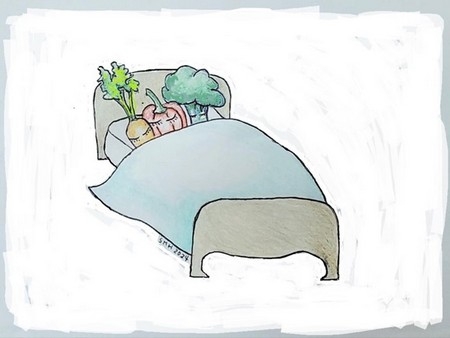
family bed 450
Pruning Roses and Cultivating Beauty
Pruning roses is not just a chore; it's an important practice for nurturing vibrant, healthy roses and fostering the beauty of your garden. In California, where the climate is favorable for growing roses, understanding the significance of pruning is key to achieving thriving and healthy roses.
Why Prune?
Pruning isn't merely about maintaining a tidy appearance; it's about promoting the overall well-being of your roses:
- Annual pruning stimulates plant and shoot growth, leading to larger blooms and a more robust structure.
- Removing dead, damaged, or diseased canes minimizes the risk of fungal infections and pest infestations, fostering plant health.
- Thinning out dense growth improves air circulation within the plant, reducing the likelihood of fungal diseases like powdery mildew and black spot.
- Shaping the plant through pruning enhances its visual appeal, creating a more attractive landscape.
When to Prune
Timing is important when it comes to pruning roses. In California, where winters are mild, the ideal time for pruning is typically between late winter and early spring. Pruning during dormancy allows the plant to focus its energy on new growth when spring arrives.
How to Prune
Pruning may seem daunting, but with the right approach, it becomes a manageable task:
- If the plant is dormant (recommended), remove all remaining leaves.
- Use sharp, clean pruning shears and loppers to make precise cuts, minimizing damage to the plant.
- Trim back old growth by about one-third to improve visibility and encourage new growth. Remove dead, diseased, or crossing canes to maintain a healthy structure.
- Make pruning cuts approximately ¼-1/2” above an outward-facing bud. Pruning cuts should be at a 45-degree angle, sloping away from the outward-facing bud.
- Create an open, vase-like shape by removing canes from the center of the plant. This promotes airflow and sunlight penetration, which is essential for plant health.
- Clear away debris and old leaves to prevent disease spread. Consider applying insecticidal soap or horticultural oil during dormancy to control pests.
Conclusion
Pruning roses is a fundamental aspect of rose care that should not be overlooked. By understanding the importance of pruning and following basic pruning principles, you can nurture thriving roses that add beauty and vitality to your garden year after year. For more details on growing roses and pruning timelines for your area contact your local UC Master Gardener Program.
Bermuda Buttercup
Bermuda buttercup (Oxalis pes-caprae) has become a tenacious and frustrating weed throughout California. From November through April, bright yellow flowers on leafless stalks and green shamrock-like leaves pop up in many of our landscapes. While it was brought from South Africa as an ornamental plant, it escaped cultivation on its route to being a chronic nuisance. It competes with other plants and is very difficult to control.
Bermuda buttercup develops from underground bulbs that produce a single vertical stem. A loose rosette of leaves will appear at soil level after the first rain. Small, whitish bulblets develop on the stem, and new bulbs form underground. Each plant can produce about a dozen small bulbs each year that easily detach from the plant and will increase the plant's spread quickly.
A couple of our favorite vertebrate pests (gophers and voles) consider oxalis bulbs to be a yummy food source and can spread the bulbs to new locations as they carry them back to their underground dens.
The best way to control Bermuda buttercup is to prevent its introduction into your garden. Don't move soil or plants from an infested site to another location that is free of the weed. Unfortunately, for many of us, it's too late for that tactic. So, what can we do when faced with the cheery yellow flowers popping up throughout the landscape?
Hand pulling can provide control if the entire plant is removed, including the underground rhizome and bulb. It's difficult to find all the bulbs without sifting the soil very carefully. Repeatedly removing the tops of the plants will eventually deplete the bulb's resources, but it can take years to be successful. It's important to remove the tops of the plants before they flower and form new bulbs.
It is difficult to smother Bermuda buttercup with thick mulch or even weed block cloth because it is a strong plant. If cardboard covered with a thick layer of mulch is used to try to smother the weed, continued vigilance in monitoring and pulling new growth will be needed in subsequent years. In one garden, weed cloth was laid under a brick walkway. The following winter, Bermuda buttercup pushed its way up through the weed cloth between the bricks. This made removing the plants even more difficult because the plants were being held in place by the weed cloth.
Several herbicides will effectively kill the tops of the plants, but will not kill the bulbs, so regrowth will occur.
Whatever method you choose to combat a Bermuda buttercup invasion, you will need to be persistent and prepared to continue in subsequent years.
For more information about managing Bermuda buttercup, see this web page: https://ipm.ucanr.edu/PMG/PESTNOTES/pn7444.html
Help Desk of the UC Master Gardeners of Contra Costa County (SEH)
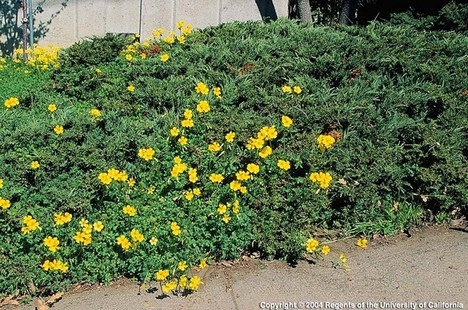
oxylis2-468
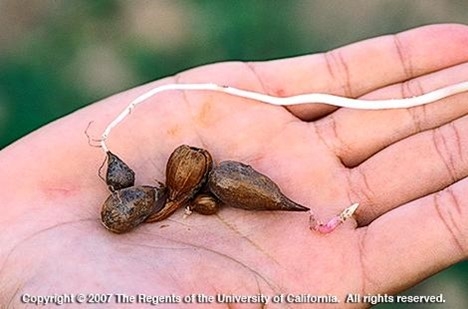
oxalis corms
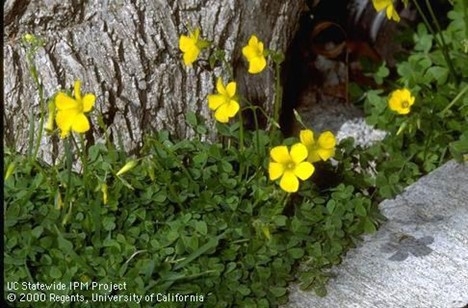
oxylis3
Blue Eyed Grass
Blue Eyed Grass By Andrea Peck UCCE Master Gardener Common name of plant: Blue-Eyed Grass Scientific name: Sisyrinchium bellum Planting area: USDA Zones 4-9 Size: 6-18” tall, 6-12” wide Bloom Season: Spring to...



